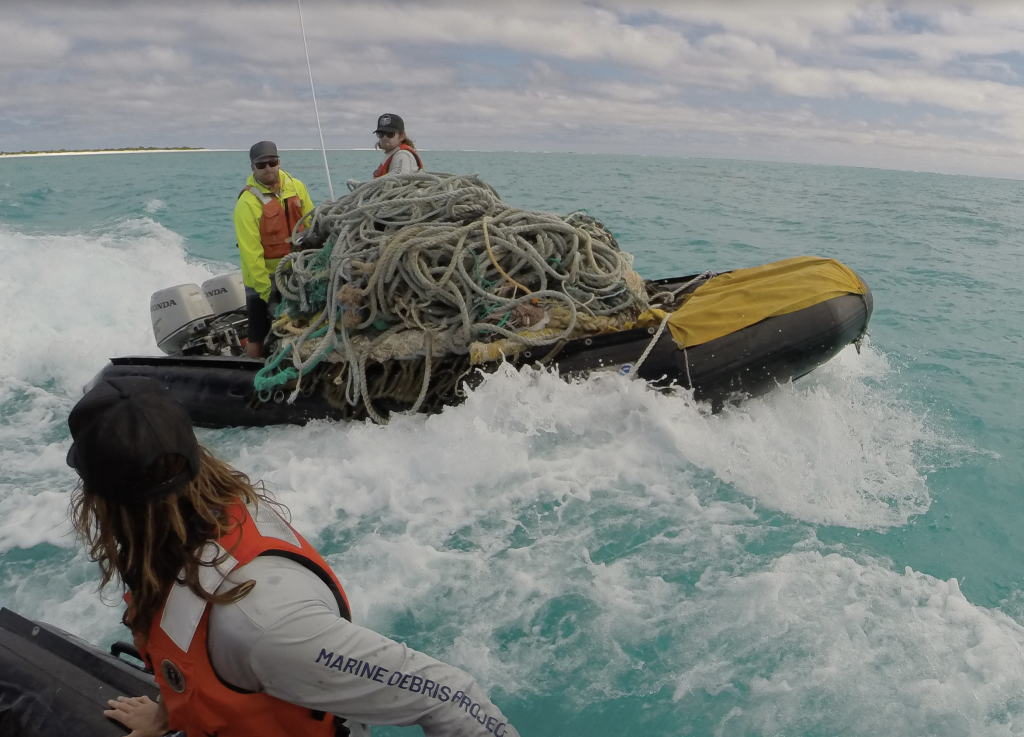47.2 Tons of Marine Debris Removed from Papahānaumokuākea Marine National Monument
An estimated 42.7 tons of marine debris was removed from the Papahānaumokuākea Marine National Monument between March 30 and April 21. The debris removal was part of a 24-day expedition carried out by a team of scientists.
The field team included 12 participants led by the local Honolulu nonprofit Papahānaumokuākea Marine Debris Project, and included staff from NOAA Fisheries, Hawaiʻi Department of Land and Natural Resources Division of Forestry and Wildlife, US Fish and Wildlife Service, and Hawaiʻi Pacific University – Center for Marine Debris Research.
The collaborative project cleaned and restored approximately 10 linear miles of shoreline habitat at the remote islands and atolls of Kamole (Laysan Island), Kapou (Lisianski Island), Kuaihelani (Midway Atoll), Hōlanikū (Kure Atoll), and Lalo (French Frigate Shoals). Hōlanikū, at the very end of the Hawaiian chain, is over 1,300 miles from Honolulu.
The effort resulted in the removal of 94,472 pounds (47.2 tons) of marine debris, of which 79,832 pounds was derelict fishing gear (ghost nets) and 14,640 pounds were ocean plastics (fishing buoys, baskets, plastic bottles and bottle caps, jugs, tires, cigarette lighters, foam and plastic fragments and many more). The Honolulu-based M/V Imua, a 180-ft charter supply vessel, served as the mission’s platform at sea.
Marine debris removal from the monument has taken place since 1996, removing a total of over two million pounds of marine debris to date.
Endangered Hawaiian monk seals, threatened green sea turtles, seabirds, and other species are routinely found entangled in derelict fishing gear in Papahānaumokuākea. During the mission, the team successfully disentangled a Hawaiian monk seal, three black-footed albatross chicks and one ʻIwa (great frigatebird).
“On day one, we were fortunate enough to be in the right place at the right time to rescue a four-year-old female endangered Hawaiian monk seal from some fishing net wrapped tightly around her neck,” said Kevin O’Brien, project lead for PMDP. “That success gave us the motivation to work as hard as we possibly could to remove every bit of debris that we could on this expedition.”
“This is the one critical issue facing the wildlife of Papahānaumokuākea that we can really do something about.” O’Brien said. “There is so much to love about this incredible place. If we’re not up there cleaning up this threat, nobody is. We’d be overlooking our kuleana (responsibility) to this place if we didn’t do everything we can to make these projects happen.”
In addition to cleanups, the expedition also included a DLNR/DOFAW Kure Atoll Field Camp resupply and personnel swap, deploying three staff and bringing home one. The Kure field crews remove derelict fishing gear year-around from the atoll. They had 27,000 pounds collected over three years, staged and ready to be picked up.
A majority of the debris will be incinerated and turned into energy for powering hundreds of Oahu homes. However, before incineration, recyclable plastics will be set aside for PMDP’s local student-led ocean plastics recycling project. In addition, approximately five tons of the derelict fishing gear (aka ghost nets) will be transported to the “net shed” at Hawaii Pacific University’s Center for Marine Debris Research for a research study attempting to identify the sources of this fishing gear.

“We intercept this debris before it is incinerated to document gear types. Our database will help identify which fishery and country of gear manufacturing is involved in this problem so that we can discuss prevention and mitigation solutions with them,” said Jennifer Lynch, co-director of Hawaii Pacific University’s Center for Marine Debris Research.
“This operation required a large number of personnel, resources and coordination–and we’ve just skimmed the surface of the marine debris problem. We hope that people see this and make adjustments in their everyday lives to help turn the tide,” said Jason Misaki, O’ahu Wildlife Program Manager for the DOFAW.
Hawaiian cultural protocol was observed each day throughout the expedition to honor the place, seek permissions, and to set intentions for conducting work in this special part of Hawaiʻi. During the mission, strict COVID-19 protocols were followed, including testing and a mandatory 14-day quarantine for all participants.
Clean-up funding and support was provided by the NOAA Damage Assessment Remediation and Restoration Program, U.S. Fish and Wildlife Service, Hawaiʻi DLNR/DOFAW, National Fish and Wildlife Foundation, USFWS Pacific Islands Coastal Program, NOAA Pacific Islands Fisheries Science Center, NOAA Office of National Marine Sanctuaries, and Office of Hawaiian Affairs, as well as private donations raised by Papahānaumokuākea Marine Debris Project and Kure Atoll Conservancy. The Hawaiʻi Nets to Energy Program, (Schnitzer Steel Co. and Covanta Honolulu/H-POWER) also supported this project.
“Marine debris poses a threat to wildlife throughout the monument,” said U.S. Fish and Wildlife Service Monument Superintendent Jared Underwood. “Working with partners is essential when it comes to addressing such a widespread problem – efforts like this clean-up demonstrate the importance of collaborative conservation management.”
Celebrating 15 years since designation, Papahānaumokuākea Marine National Monument is the largest contiguous fully protected conservation area under the U.S. flag, and one of the largest marine conservation areas in the world. It encompasses 582,578 square miles of the Pacific Ocean (1,508,870 square kilometers) – an area larger than all the country’s national parks combined.
“Papahānaumokuākea is one of the most amazing landscapes on earth, central to many Native Hawaiian narratives- a place where nature and culture are one,” said Athline Clark, NOAA superintendent for PMNM. “It sustains the most vulnerable Hawaiian wildlife species, and nearly all of its habitat is used by seabirds, turtles and seals for critical nesting, burrowing, basking and pupping.”























